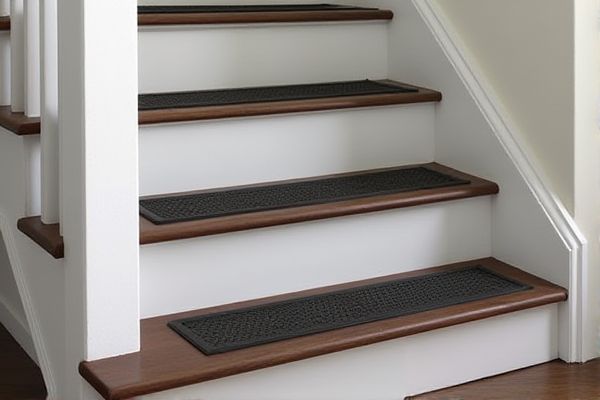
Perforated metal treads offer enhanced slip resistance and better drainage, making them ideal for outdoor or industrial environments where safety is a priority. Explore the article to discover how your choice between perforated and solid treads impacts durability, maintenance, and performance.
Table of Comparison
| Feature | Perforated Metal Treads | Solid Treads |
|---|---|---|
| Material | Steel, Aluminum with holes | Steel, Aluminum without holes |
| Slip Resistance | High, due to perforations | Moderate, depends on surface treatment |
| Drainage & Debris | Excellent, allows water and debris to pass | Poor, water and debris accumulate |
| Weight | Lighter, reduced material use | Heavier, solid construction |
| Durability | Good, but perforations may weaken structure | High, solid and robust |
| Maintenance | Lower, easier to keep clean | Higher, may require frequent cleaning |
| Cost | Generally lower | Generally higher |
| Applications | Industrial, outdoor stairs with drainage needs | Indoor, architectural stairs requiring solid surface |
Overview of Perforated Metal Treads and Solid Treads
Perforated metal treads provide superior slip resistance and enhanced drainage, making them ideal for industrial staircases and outdoor applications where safety and durability are critical. Solid treads, typically made from flat steel or aluminum, offer a smooth, clean surface preferred in architectural or indoor environments for a sleek appearance and easy maintenance. Both types vary in weight capacity, corrosion resistance, and installation methods, with perforated treads excelling in ventilation and debris shedding compared to the robust, solid structure of solid treads.
Material Composition and Manufacturing Processes
Perforated metal treads are typically made from steel or aluminum sheets with punched holes, offering enhanced slip resistance and drainage, while solid treads are usually fabricated from rolled or flat bars providing higher structural strength and durability. The manufacturing process for perforated treads involves punching or stamping to create patterns that improve grip and airflow, whereas solid treads are often produced through cutting, welding, or pressing techniques to achieve a continuous surface. Your choice between them depends on the specific application requirements, balancing factors like material thickness, corrosion resistance, and load-bearing capacity.
Slip Resistance and Safety Features
Perforated metal treads provide enhanced slip resistance by allowing water, oil, and debris to pass through, reducing the risk of slips and falls in wet or oily environments. Their textured surface and open design improve traction even in harsh conditions, making them a safer choice for industrial and outdoor stair applications. Solid treads, while durable, may retain liquids and contaminants on the surface, increasing slip hazards compared to perforated options.
Durability and Load-Bearing Capacity
Perforated metal treads provide enhanced grip and drainage but may have slightly reduced load-bearing capacity compared to solid treads, which offer maximum durability and strength under heavy loads. Your choice depends on the specific application; solid treads excel in environments demanding high structural support, while perforated treads balance durability with slip resistance. Both types are constructed from robust metals like steel or aluminum, ensuring long-lasting performance in industrial and commercial settings.
Maintenance and Cleaning Requirements
Perforated metal treads require less frequent cleaning due to their open design, allowing dirt and debris to fall through and preventing buildup, which reduces maintenance time. Solid treads, however, tend to accumulate dust, mud, and moisture on their surface, demanding regular cleaning to maintain safety and appearance. The reduced debris retention in perforated treads ultimately minimizes slip hazards and extends the lifespan of the stair components compared to solid treads.
Aesthetic Appeal and Design Flexibility
Perforated metal treads offer enhanced aesthetic appeal with their modern, industrial look and customizable patterns that allow for unique design possibilities. Solid treads provide a clean, uniform appearance that suits traditional or minimalist styles, but they lack the visual intricacy and ventilation benefits of perforated options. Your choice depends on whether you prioritize design flexibility and dynamic texture or prefer a sleek, consistent surface.
Cost Comparison and Budget Considerations
Perforated metal treads typically cost more upfront than solid treads due to the added manufacturing process and material used for the perforations, affecting overall budget allocation. However, their enhanced slip resistance and drainage capabilities can reduce long-term maintenance expenses, providing better value for safety-conscious projects. When planning your budget, weigh the higher initial investment against potential cost savings from reduced repairs and improved durability.
Suitability for Indoor vs. Outdoor Applications
Perforated metal treads excel in outdoor applications due to their superior drainage and slip-resistance, preventing water and debris accumulation. Solid metal treads are better suited for indoor environments where consistent footing and aesthetic appeal are prioritized without exposure to harsh weather conditions. Choosing between perforated and solid treads depends on the specific environmental demands and safety requirements of the application.
Environmental Impact and Sustainability
Perforated metal treads significantly reduce material usage compared to solid treads, lowering the overall carbon footprint of the manufacturing process. Their enhanced ventilation and drainage capabilities contribute to longer lifespan and reduced maintenance, promoting sustainability in infrastructure. Recyclability of perforated metal further supports eco-friendly practices by enabling material reuse and minimizing landfill waste.
Choosing the Right Tread Type for Your Project
Perforated metal treads provide superior slip resistance and drainage, making them ideal for outdoor or industrial applications where safety and durability are critical. Solid treads, on the other hand, offer a smoother surface that is easier to clean and maintain, suitable for indoor environments or areas where dirt and debris are less of a concern. Evaluating your project's specific requirements for traction, maintenance, and environmental conditions helps you select the most effective tread type for your needs.
 homyna.com
homyna.com